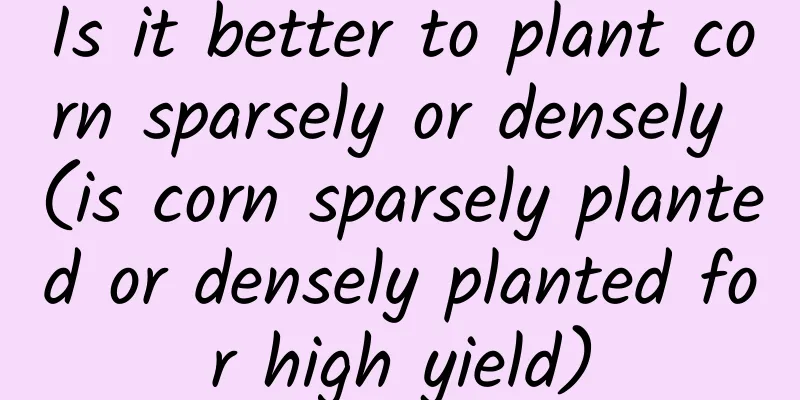Is it better to plant corn sparsely or densely (is corn sparsely planted or densely planted for high yield)

|
Whether it is better to plant corn densely or sparsely is actually a difficult question to answer. Corn is a high-yield crop. In order to tap its potential for increased production, the Ministry of Agriculture has proposed a planting measure of "one increase and four changes". The "one increase" is to increase the planting density, and the "four changes" are to change to high-yield, dense-resistant varieties, change intercropping to flat sowing, change extensive fertilization to formula fertilization, and change manual planting to mechanized operations. Both scientific research and production practice have proved that corn yield can be increased if corn is planted at a reasonable density and fertilized scientifically. Why was the average yield of corn in my country less than 200 kilograms per mu in the 1950s? The main reason was the lack of varieties and planting density. I once asked my father, and he said that in the 1950s, there were only about 2,000 corn seedlings left per acre, and the varieties were mainly old farmers' varieties, and there was insufficient fertilizer and water, so how could the yield be high? Later in the 1960s and 1970s, hybrid corn varieties began to be planted, with the density increased to about 2,500 plants per acre and the yield reaching more than 200 kilograms. In the 1990s, with the popularization of compact corn varieties, the corn planting density was greatly increased. Coupled with high-yield supporting management techniques, corn yields soared to more than 700 kilograms per mu. From the characteristics of corn plants, under the premise that the yield per plant is basically stable, the more plants per mu, the higher the yield. Because corn is not like wheat or rice that can tiller, corn generally has a single ear, and even if there are two ears, the size is not too big. Therefore, in order to increase corn yields, we must first increase and stabilize the weight of a single ear and second increase the number of plants per mu. Increasing density is the most direct and effective measure to increase yield, and density is a cultivation measure that is easier to influence, master and control by humans . The planting density of corn must be reasonable, not the more the better.Many years ago, because the seed drill did not sow single seeds precisely, the seedlings had to be thinned out after they emerged to leave the appropriate number of plants. There is a family in my village who did not thin out the corn seedlings for various reasons. The corn in the field is like a wind barrier, with 2-3 ears in one mound. Although there are more ears, they are too small and the yield is low, less than 2/3 of the yield per mu under normal management. If the corn planting density is too high and there is a lack of light, nutrients or water, it will lead to baldness, small ears, or even empty plants. The biggest risk is that over-crowding can easily cause lodging . These problems can be solved by changing to dense-tolerant varieties, increasing fertilizer application, and timely watering. Therefore, we should take appropriate measures according to local conditions and plant them reasonably densely. The so-called reasonable close planting should determine the appropriate planting density based on the selected corn variety, climatic conditions, soil fertility, management conditions and other conditions . First, you need to determine the appropriate density range based on the characteristics of the variety you choose, and then determine the appropriate density range based on specific production conditions, such as soil fertility, whether there is sufficient fertilizer and water, and whether there is sufficient time for management. Generally speaking, the principle of reasonable corn planting densityVarieties with flat leaves are prone to shading and other problems because of their flamboyant leaves, but they have strong single-plant production capacity and cannot tolerate dense planting. They must be planted sparsely and rely on single-plant yield to increase production. The sowing density is generally around 3,500 plants per mu. A compact corn variety with upward-pointing leaves and weak single-plant productivity, it tolerates dense planting and relies on increasing density to increase yield. The sowing density is generally 4,000-5,000 plants per mu . The semi-compact corn varieties that are between the two have single-plant productivity and density tolerance between the compact and flat types, and the suitable sowing density is generally 3,500-4,000 plants per mu . In addition to the plant shape of corn, the height of the plant, the length of the growing period, the size of the corn cob, etc. also have a certain impact on the reasonable density of planting. When we are not sure how many plants of this variety should be planted per mu, it is best to sow according to the appropriate density recommended on the seed packaging bag. Corn seeds are now mostly packed in bags, and the machinery is also advanced, which can sow single seeds precisely, so the breeding department will reserve enough sowing amount per mu for each bag according to the characteristics of the variety, and also introduce the spacing between plants and rows. There are issues that require attention in planting management, such as fertilizer and water, pest and disease control, whether to control vigorous growth, etc., as well as suitable sowing areas, soil conditions, etc. You can select seeds accordingly, and adjust the plant spacing, sowing and management during the growing period. |
Recommend
How to grow succulent snow lotus
1. Maintenance methods 1. Temperature: As it is n...
The cultivation methods and precautions of Syngonium (Syngonium pictures and cultivation techniques)
Syngonium is relatively easy to propagate, the cu...
How to cultivate purse flower
1. Soil selection Loam can be made from everyday ...
A comprehensive list of plants that will bring good luck in 2018! Are you sure you don't want to plant one?
1. Bamboo The bamboo mentioned here is not the ta...
How to change the soil and pot of large potted flowers
Time to change the soil and pot of large potted f...
How to grow chrysanthemums to make them overflow (cultivation methods and precautions for chrysanthemums)
Medal chrysanthemum is also known as medal flower...
The Difference Between Yacon and Sweet Potato
Appearance Yacon and sweet potato look similar on...
How to choose South American narcissus bulbs
Look at the shape The bulbs of high-quality South...
Are grapevines shade-loving or sun-loving plants?
Do grapevines prefer shade or sun? Grapevines are...
How to plant Dendrobium chrysotoxum
1. Temperature requirements Dendrobium chrysanthe...
Characteristics of green radish
1. Appearance characteristics Pothos is an evergr...
How to water mint
Growth habit Mint is a typical perennial herb tha...
Cucumber planting conditions and regional requirements for the growing environment
Cucumber Growing Conditions Cucumbers prefer a wa...
How to grow yacon
1. Maintenance methods 1. Temperature: It is not ...
How to grow potted violets
For potted violets, you should choose short-plante...









